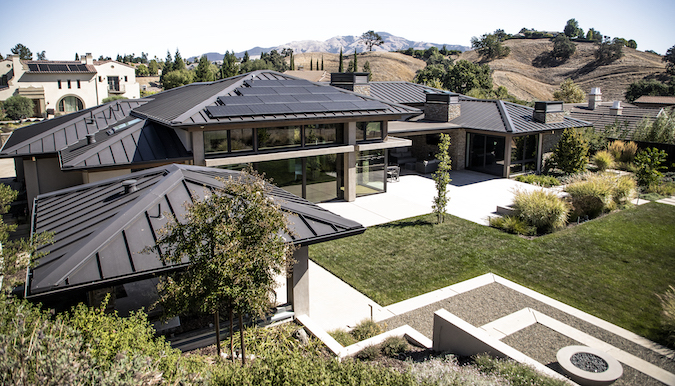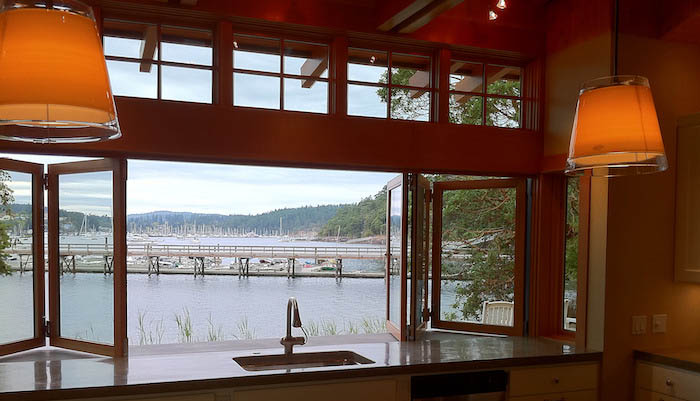Designers and builders are looking at the interdependency of walls, roofs, windows, insulation, air sealing, and HVAC to meet new energy codes.
Today’s highly insulated, tightly sealed homes require little heating or cooling, but improper air sealing and insulation can be problematic. With a basic understanding of building science, you can avoid moisture and air quality problems.

JELD-WEN Siteline® Casement windows showcase elegance, thoughtful engineering, and energy efficiency.
Build tight, ventilate right” is a mantra among high-performance builders. Their homes are highly insulated and tightly sealed to prevent drafts and include efficient mechanical systems and well-insulated windows to maintain clean, comfortable indoor air. The most-advanced builders specialize in zero energy ready (ZER) homes that require so little heating or cooling that a modest solar array will satisfy their annual power needs.
If you’re not yet building this way, you probably will soon, thanks to evolving energy codes. “I predict that by 2030 every new home in North America will have to meet zero energy standards,” says Andy Oding, a former homebuilder and director of building science at Building Knowledge Canada.
The problem is that improper air sealing and insulation can cause condensation, rot, and mold. In the past, builders were taught that walls need to “breathe” to prevent such issues. But with today’s tightening code requirements, drafty walls are not a compatible solution.
The good news is that with a basic understanding of building science, you can avoid moisture and air quality problems. It starts with a systems approach to design and construction in which walls, roofs, windows, insulation, air sealing, and HVAC are all treated as interdependent. The study of these interdependencies is the field of building science.
“It’s not difficult to build an efficient, durable, healthy home,” Oding says. “But you need to understand the principles behind how the home’s elements interact with one another.”

JELD-WEN EpicVue™ casement awning windows are hinged at the top to open out and provide maximum ventilation.
New building materials require moisture management
Most construction defects are moisture related. That’s because today’s homes are less forgiving than ever, thanks in part to something called hygric buffer capacity, or the ability of materials to absorb and release moisture. Older homes built with stone, brick, plaster, and old-growth lumber are more breathable and absorb moisture without harm. And their drafty walls make it easy for those materials to dry.
In contrast, newer homes use engineered materials and lightweight, new-growth dimensional lumber, none of which can absorb much moisture without damage. Complicating things further, the builder then puts these materials into highly insulated, airtight walls.
The most obvious moisture threats come from rain and snow, and even a small leak can cause big problems over time. While the consequences of leaks are potentially more serious than in the past, best practices for preventing them haven’t changed. It’s a matter of using good flashing and waterproofing details. Trade publications such as the Journal of Light Construction have lots of field-proven waterproofing techniques.
Control the flow of heat, water, and air
The key building science principle to understand is how to control the flow of heat, moisture, and air through building assemblies. (You can also think of these as fire, air, and water, three of the four classical elements.) The important word here is control. Heat, moisture, and air will work their way into wall, ceiling, and roof assemblies no matter what you do. The trick is minimizing those flows, eliminating opportunities for condensation, and giving moisture that does get into the wall a way out.
A big part of limiting heat flow is properly installing insulation and high-quality windows. Insulation achieves its nominal R-value when it fills all framing cavities, including hard-to-reach, sometimes-hidden gaps and voids. Blown fiberglass, which easily fills voids inside walls, is more effective and comparable in cost to batts.

JELD-WEN Siteline® Casement Pocket windows are beautiful and easy to install for replacement and renovation projects.
How to choose the right windows
Good windows are critical to minimizing heat flow. In the 1990s, windows covered 8 to 10 percent of the average new home’s wall area; today they cover 18 to 25 percent. Oding says that in a cold-climate home with that much glass, upgrading from dual- to triple-pane windows will add more R-value to the home than putting an extra two inches of foam on the exterior, a result you can confirm with a performance modeling software program like REM/Design or Energy-10. And while triple-pane insulating glass can cost 20 to 30 percent more than dual-pane, it can be used strategically to stop the transfer of heat and cold.
“Placing a fixed triple-pane window above an operable double-pane will give you good light with only a small energy penalty,” says Jason Kantola, coordinating certification manager at JELD-WEN.
As a side benefit, triple-pane also does a better job muffling sound. Kantola foresees more buyers demanding it on walls that face busy roads, railroad tracks, or noisy neighbors.
According to Kantola, there is another step you can take to boost performance: “You can get performance gains by using awning or casement windows where possible, because they’re more airtight than double-hungs,” Kantola says.
Engineered to deliver top-of-the-line style and performance, JELD-WEN’s Siteline and EpicVue window lines are available with triple pane glass and AuraLast® pine to protect against termites, wood rot, and water damage.
Air sealing options that go beyond code
For additional sealing, LaLiberte recommends AeroBarrier. To understand this product, think “Fix-a-Flat” for homes. The applicator tapes off doors, windows, and duct grilles, then pressurizes the house with a blower door. Molecular-sized acrylic latex particles are sprayed into the air and forced by the pressure into unsealed gaps in the building envelope, where they coagulate on the edges of those gaps and slowly seal them. The applicator constantly monitors air leakage and can keep adding spray until reaching the target number.
Building science training
There are other details and nuances a building pro needs to understand. Having a solid foundation in building science helps.
Joe Lstiburek of Building Science Corporation offers a live, virtual seminar on “Building Science Fundamentals” throughout the year. Construction Instruction provides online training as well as live classes at its Denver facility. EEBA holds seminars as well as at its annual summit.
Learn how to make a home durable and healthy with JELD-WEN
To access additional professional resources and performance testing specifications, visit JELD-WEN’s Pro-Site.
To get help with your project, contact JELD-WEN. Learn about the efficiency and sustainability of JELD-WEN windows and doors.
See why JELD-WEN’s extensive offering of high-quality wood and vinyl windows includes the right windows to support your next zero energy build.
Enhance your projects with interior doors and exterior doors that bring design, efficiency, and functionality home.
Create a connection between indoor and outdoor living spaces with patio doors.



